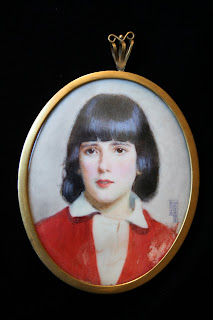 The story of photographic jewelry is also the story of the end of portrait miniatures. The invention of Daguerreotype photography in 1838 caused a decline in portrait miniature production after 1840 and a very sharp decline after 1850. Indeed, in 1865 the South Kensington Museum, later the Victoria and Albert Museum, in London held the first major museum exhibition of 4000 portrait miniatures. In the last half of the nineteenth century, portrait miniatures were less likely to be commissioned and more likely to be the domain of the antique collector and museum curator.
The story of photographic jewelry is also the story of the end of portrait miniatures. The invention of Daguerreotype photography in 1838 caused a decline in portrait miniature production after 1840 and a very sharp decline after 1850. Indeed, in 1865 the South Kensington Museum, later the Victoria and Albert Museum, in London held the first major museum exhibition of 4000 portrait miniatures. In the last half of the nineteenth century, portrait miniatures were less likely to be commissioned and more likely to be the domain of the antique collector and museum curator. Photographs were less expensive than miniatures and continued to become increasingly less expensive as the nineteenth century progressed. “Pictures drawn by the sun,” as they were sometimes called, were also perceived to be more accurate likenesses than portrait miniatures. However, like miniatures, photographs were frequently housed in jewelry and augmented with hairwork. By the conclusion of World War I, the addition of hairwork came to an end.
Photographic revolving brooch, circa 1865, with palette worked hair on the reverse.

The photographs were occasionally painted to add color to the skin and details of the dress. Painted photographic revolving brooch, circa 1850s, with black enamel and hairwork reverse.


In the 1860s several French photographers began enameling their photographs in order to have a long lasting colored photograph that would not fade. The enamel miniature below was created by Lafon de Camarsac c. 1870 of a Parisian woman wearing Irish crochet lace adornment.

The albumen print portrait below, c. 1870, was taken in the studio of Mathieu Deroche and provides an example of the work from the other master of enamel photography working in Paris at the same time.

A very few portrait miniaturists, like John Henry Brown and John Wood Dodge, were successfully able to continue producing miniatures after 1860 by painting in a glossy, photo-realistic manner. This finely detailed portrait miniature on ivory was painted circa 1880 by John Henry Brown (1818-1891) and housed in a bracelet clasp.


Colored photographic locket, circa 1890s, with hair on the reverse.


Colored photographic locket, circa 1900s, with basket weave hairwork reverse.


By the early twentiety century, artists began a brief revival of portrait and eye miniatures. This portrait miniature by Frederick Boyd Waters (Canadian 1879-1967) watercolor on ivory, c. 1920, displays an influence from the craftsman renaissance of the same period.

No comments:
Post a Comment